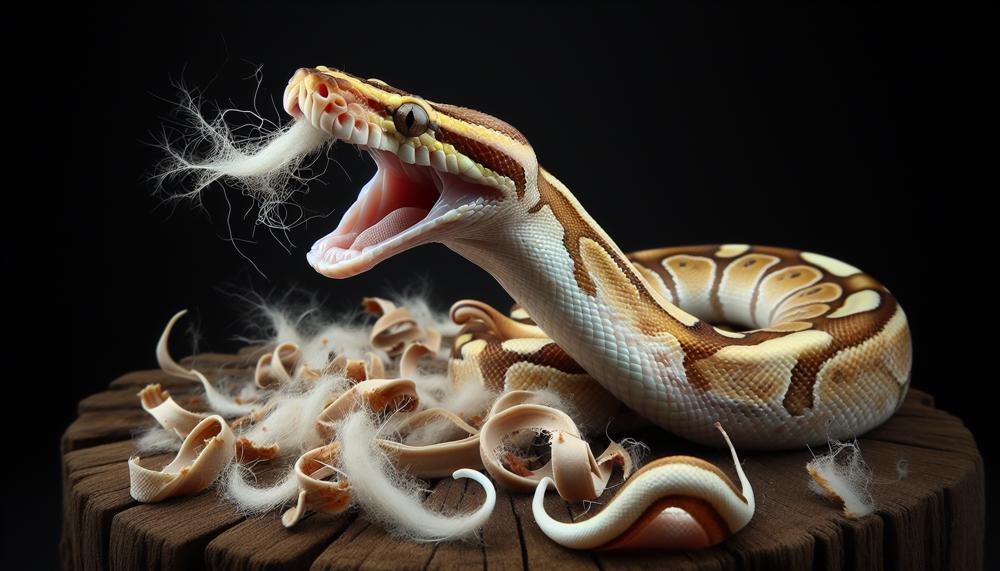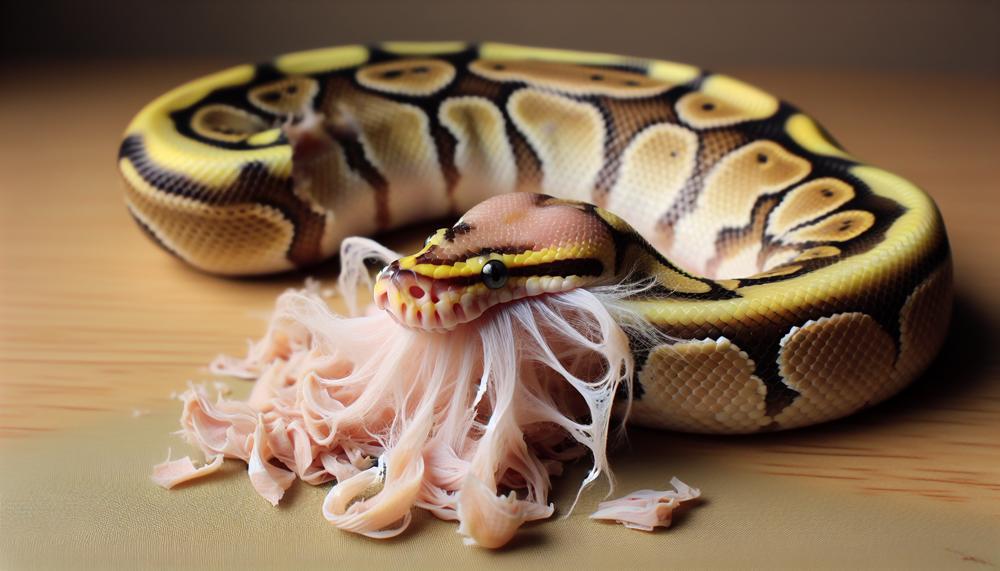If you’re a first-time snake owner or simply curious about these captivating creatures, you may have come across information about their shedding process. But what exactly is it? And why does it happen? Fear not, we have all the answers for you in this post.
In this article, we will delve into:
- The fundamentals of ball python shedding – from defining it to understanding its purpose
- The frequency of shedding and factors that can affect a ball python’s shedding cycle
- Indications that your ball python is preparing to shed and ways to assist them during this process
- Common misconceptions surrounding ball python shedding
- Tips for maintaining optimal humidity levels to facilitate healthy shedding
- What to do if your ball python struggles with shedding or experiences a stuck shed
Whether you’re an experienced snake owner or a novice enthusiast, comprehending the intricacies of ball python shedding is crucial for ensuring your pet’s well-being. So let’s embark on this scaly journey together.
Contents
- 1 Key takeaway:
- 2 Understanding the Shedding Process of Ball Pythons
- 3 Common Reasons for Ball Python Shedding Issues
- 4 Signs and Symptoms of Shedding Issues in Ball Pythons
- 5 Tips and Methods to Help with Ball Python Shedding
- 6 When to Consult a Reptile Veterinarian?
- 7 Some Facts About Why Ball Pythons May Not Be Shedding:
- 8 Conclusion
Key takeaway:
When it comes to ball pythons, proper shedding is essential for their health and well-being. However, there are several common reasons why a ball python may have trouble shedding properly. These include inadequate humidity levels, improper hydration, poor habitat hygiene, and high stress levels.
Inadequate humidity levels can lead to dry and stuck shed, making it difficult for the snake to shed its skin. To prevent this, you can mist the enclosure regularly or provide damp hiding spots for your python to help maintain proper humidity levels.
Improper hydration is another common reason for shedding issues in ball pythons. If a snake’s skin becomes too dry, it can make shedding difficult and uncomfortable. To avoid this, always ensure that your python has access to clean water at all times and reduce handling during the shedding process.
Poor habitat hygiene can also cause problems with shedding. A dirty habitat can irritate a snake’s skin and even lead to infections. To prevent this, it is important to regularly clean and disinfect the enclosure.
Lastly, high stress levels can disrupt the shedding process and result in incomplete sheds. To minimize stress for your ball python, provide adequate hiding spaces and avoid handling them during the shedding process.
Understanding the Shedding Process of Ball Pythons
One of the most common obstacles that ball pythons face when shedding is low humidity. Other factors that can also affect the shedding process include irregular feeding, old age, underlying health issues, incorrect temperature and humidity levels, skin conditions, and excessive handling during shedding. These issues can lead to incomplete or stuck sheds, causing discomfort and potential health problems for your snake.
To ensure a successful shed for your ball python, there are certain steps you can take.
First, make sure the humidity levels in their enclosure are at the appropriate level. Ball pythons need a humidity level of 50-60% for a successful shed. You can achieve this by misting the enclosure daily, providing a humid hide, or using a reptile fogger.
Proper hydration is also crucial for a successful shed. Make sure your ball python has access to clean water at all times. Dehydration can cause dry skin and make it difficult for your snake to shed properly. Additionally, handling your snake frequently during the shedding process can cause stress and disrupt the shedding process. It is best to minimize handling during this time and allow your snake to shed in peace.
If your ball python is experiencing stuck shed or an incomplete shed, you can provide them with a bath. Fill a shallow container with lukewarm water and let your snake soak for 20-30 minutes. This will help loosen the shed and make it easier to remove. You can also gently rub the stuck shed with a soft cloth or use a shedding aid tool specifically designed for snakes.
In some cases, underlying health issues may be the cause of your ball python’s shedding problems. If you suspect this is the case, it is important to consult with a reptile veterinarian for proper diagnosis and treatment.
Table:
| Common Causes of Improper Shedding | Solutions |
| Low Humidity | Mist enclosure daily, provide humid hide, or use reptile fogger |
| Irregular Feeding | Ensure regular and appropriate feeding schedule |
| Old Age | Provide extra care and attention during shedding process |
| Underlying Health Issues | Consult with a reptile veterinarian for proper diagnosis and treatment |
| Incorrect Temperature and Humidity Levels | Monitor and adjust levels in enclosure accordingly |
| Skin Conditions | Consult with a reptile veterinarian for proper diagnosis and treatment |
| Excessive Handling During Shedding Process | Minimize handling and allow snake to shed in peace |
Common Reasons for Ball Python Shedding Issues
| Common Reasons for Ball Python Shedding Issues | How to Resolve Them |
| Insufficient Humidity Levels | To avoid shedding issues, it is essential to maintain proper humidity levels in the snake’s enclosure. This can be achieved by misting the enclosure regularly or using a humidifier. The ideal humidity level for ball pythons is between 50-60%. This ensures that the snake’s skin stays hydrated and can shed easily. |
| Inadequate Diet or Nutritional Imbalances | A poor diet can also lead to shedding problems in ball pythons. It is crucial to provide a well-balanced and appropriate diet for your snake. This includes feeding whole prey items or a variety of frozen-thawed rodents, which can help prevent nutritional deficiencies and ensure smooth shedding. |
| Stress or Environmental Factors | Stress can also contribute to shedding issues in ball pythons. It is important to minimize stressors in the snake’s habitat, such as loud noises, frequent handling, or overcrowding. Providing adequate hiding spots and a quiet environment can help your snake feel safe and secure, reducing stress and promoting healthy shedding. |
| Retained Eye Caps | If your snake has retained eye caps, gently rub them off with a damp cloth or use an ophthalmic lubricant recommended by a veterinarian. This will help remove any remaining skin and prevent eye infections or other complications. |
| Incomplete Sheds | If your snake has an incomplete shed, soaking it in lukewarm water for 15-20 minutes can help soften the retained skin. You can then gently rub off any remaining skin with a damp cloth or your fingers. This will ensure that the snake’s skin is smooth and healthy. |
| Stuck Skin near the Tail or Vent | In case of stuck skin near the tail or vent, soaking your snake in lukewarm water for 15-20 minutes can help loosen the skin. Gently rub off the skin using a damp cloth or your fingers to prevent any potential health problems. |
Signs and Symptoms of Shedding Issues in Ball Pythons
Proper husbandry practices play a crucial role in preventing shedding issues in ball pythons. However, even with the best care, our beloved pets may still face difficulties during the shedding process.

As a responsible snake owner, it is essential to be aware of the signs and symptoms of shedding issues in ball pythons so that you can provide them with the necessary care and support.
Dull Skin Coloration
One of the most noticeable signs that a ball python is about to shed is a dull skin coloration. This occurs because the outer layer of skin that is ready to be shed appears darker and less vibrant than the rest of their skin.
This dullness is caused by a build-up of oils and dirt on the skin, which acts as a protective layer during the shedding process.
Pink Tint on Belly
Another sign to look out for is a pink tint on your ball python’s belly.
This occurs due to increased blood flow underneath the skin as new skin develops. It is a natural part of the shedding process, and the pink tint will disappear once the shed is complete.
Silvery Sheen on Skin
As the old skin loosens and separates from the new skin, it may appear silver or shiny in certain areas.
This is a clear indication that your ball python is preparing to shed and is completely normal.
Dull Eyes
During shedding, ball pythons’ eyes become cloudy or bluish in color.
This is because they produce a fluid between their old and new eye caps to help them detach from their old skin. It is vital not to handle your snake during this time as their impaired vision may make them feel vulnerable.
Loss of Appetite
Ball pythons may also experience a loss of appetite leading up to and during shedding.
This happens because they focus their energy on shedding rather than eating. It is crucial to monitor your snake’s weight during this time and offer food once the shed is complete.
Unwillingness to Come Out or Be Handled
As shedding can be a vulnerable time for ball pythons, they may become more defensive or aggressive when handled.
It is important to respect your snake’s boundaries and avoid handling them until their shed is complete.
Lethargy
During shedding, ball pythons may exhibit signs of lethargy. This occurs because they conserve energy for the shedding process.
It is essential to provide a comfortable and quiet environment for your snake during this time.
Increased Time in a Moist Hide
To aid in the shedding process, ball pythons require a humid environment. You may observe that they spend more time in their moist hide during this time.
It is crucial to ensure that their humidity levels are maintained at 60%-70% during a shed cycle.
Tips and Methods to Help with Ball Python Shedding
Shedding is a natural process for ball pythons, essential for their growth and hygiene. However, it can be a challenging task for keepers to ensure that their reptile sheds properly. To assist with this process, it is crucial to understand the shedding process and recognize signs that indicate a shedding cycle is about to begin.
Here are some effective techniques that can help with ball python shedding:
Understand the Shedding Process:
Before attempting to assist your ball python with shedding, it is essential to know how the process works.
Snakes shed to replace old skin and grow, and it is a natural part of their life cycle.
Recognize Signs of Shedding:
As a responsible keeper, it is crucial to keep an eye out for signs that indicate your ball python is about to shed.
These include dull skin and decreased appetite.
Create Optimal Conditions:
To facilitate proper shedding, it is vital to maintain adequate humidity levels in the enclosure.
Providing a hiding spot and ensuring your snake is adequately hydrated can also help create optimal conditions for shedding.
Be Aware of the Timeline:
The shedding process typically takes 10-14 days and has four stages: pre-shedding, shedding, post-shedding, and eye cap removal. Knowing this timeline can help you anticipate when your snake will need assistance.
Assist When Needed:
If your ball python has difficulty shedding its eye caps or skin, you may need to gently remove them. However, if you are not comfortable doing so, or if your snake is uncooperative, it is best to seek professional help from a veterinarian or experienced reptile keeper.
Practice Proper Husbandry:
Proper husbandry practices and minimizing stress can also prevent shedding issues.
Ensure that your enclosure meets the necessary temperature and humidity levels and provide adequate hiding spots for your snake.
Wait Before Feeding:
It is recommended to wait until after your ball python has completed its shed cycle before offering food again.
This will help prevent any potential complications that may arise from feeding during the shedding process.
In conclusion, understanding the shedding process, recognizing signs of shedding, creating optimal conditions, and seeking professional help when needed are key techniques to help with ball python shedding.
When to Consult a Reptile Veterinarian?
There are a multitude of indications that might suggest it is time to seek guidance from a reptile veterinarian for your ball python’s shedding issues. These may include:
- Lack of Shedding: If your ball python has not shed within the anticipated timeframe, it could be an indication of an underlying health problem and necessitates a visit to the vet.
- Patchy Shedding: Consistent shedding in patches rather than a complete piece could also be an indication of an underlying health issue.
- Discolored or Abnormal Skin Texture: If your ball python’s shed skin appears discolored or has an unusual texture, it could be a sign of an infection or injury that requires medical attention.
- Difficulty Shedding: If your snake is struggling to remove its old skin or taking longer than usual to shed, it could be due to dehydration, poor nutrition, or underlying health conditions.
- Changes in Behavior or Appetite: Any alterations in your ball python’s behavior or appetite during the shedding process could be a warning sign for an underlying health issue.
- Visible Skin Abnormalities: Cuts, lesions, or blisters on your ball python’s skin are signs of a serious skin condition and require immediate veterinary care.
If you observe any of these signs, it is crucial to consult a reptile veterinarian for precise diagnosis and treatment. Remember, early detection and treatment are imperative in maintaining the health and happiness of your ball python.
Some Facts About Why Ball Pythons May Not Be Shedding:
As a reptile owner, it’s crucial to understand that there are several factors that can contribute to a ball python experiencing difficulty shedding. These include age, size, growth rate, health status, hydration levels, stress levels, habitat hygiene, and feeding during a shed cycle.
It’s essential to keep these factors in mind and take the necessary steps to ensure your pet has a smooth shedding process.
Firstly, age and size can play a role in how well a ball python sheds its skin. Younger snakes may shed more frequently due to their rapid growth rate, while older snakes may take longer between sheds. Additionally, larger snakes may have more trouble shedding than smaller ones, as they have more surface area to cover.
The overall health of your snake is also crucial in achieving a successful shed. Ensuring proper hydration levels is key, as dehydration can cause the skin to become dry and difficult to shed. Stress can also impact the shedding process, so it’s vital to provide hiding spaces and minimize any potential stressors in your snake’s environment.
Maintaining proper humidity levels is essential for a problem-free shed. Inadequate humidity can lead to the skin becoming dry and difficult to remove. It’s recommended to provide a humid hide for your snake during the shedding process and regularly mist their enclosure to maintain proper humidity levels.
In some cases, retained eye caps or skin on the tail or vent area can hinder the shedding process. However, this can easily be remedied by giving your snake a soak in water. If your snake continues to experience difficulty shedding or shows other signs of health problems, seeking veterinary help is highly recommended.
Also Read: Are Corn Snakes Good Pets?
Conclusion
In summary, understanding the shedding process of ball pythons is crucial for their overall health and well-being.
Maintaining proper humidity levels and addressing common issues like stuck sheds are just some of the factors that can affect a ball python’s shedding cycle. By being aware of these factors and taking necessary steps, such as providing a well-balanced diet and minimizing stress, we can ensure successful sheds for our scaly companions.
It’s important to closely monitor your snake’s shedding cycle and seek advice from a veterinarian if any concerning signs or symptoms arise.






